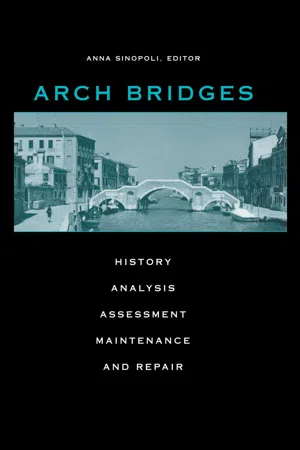
- 450 pages
- English
- ePUB (mobile friendly)
- Available on iOS & Android
Arch Bridges
About This Book
Modern structural engineering surprises us with the mastery and certainty with which it plans and carries out daring projects, such as the most recent metal or concrete bridges, whether they be suspension or arch bridges.
On the other hand, little is yet known about the state of knowledge of construction science and techniques which, well before the arrival of modern methods based on the mechanics of deformable continua, made it possible in the past to erect the vaulted masonry structures rthat we have inherited.
The fact that these have lasted through many centuries to our time, and are still in a fairly good state of conservation, makes them competitive, as far as stability and durability are concerned, with those constructed in other materials.
Although it is known that the equilibrium of the arch is guaranteed by any funicular whatsoever of the loads, contained inside the profile of an arch, finding the unique solution is not such a certainty. In other words, the problem of the equilibrium of vaulted structures is 'Poleni's problem', the one for which the Venetian scientist was able to give an exemplary solution on the occasion of the assessment of the dome of St. Peter's.
Arch Bridges focuses on the main aspects of the debate about the masonry arch bridge: History of structural mechanics and construction, theoretical models, analysis for assessment, numerical methods, experimental and non-destructive testing, maintenance and repair are the topics of the Conference. The breadth and variety of the contributions presented and discussed by leading experts from many countries make this volume an authoritative source of up-to-date information.
Frequently asked questions
Information
Numerical methods for strength assessment
Finite/discrete element models for assessment and repair of masonry structures
1 INTRODUCTION
Table of contents
- Cover
- Half Title
- Title Page
- Copyright Page
- Table of Contents
- Preface
- History of structural mechanics
- History of construction
- Equilibrium and limit analysis
- Theoretical models and analysis
- Numerical methods for strength assessment
- Non-destructive testing
- Dynamics and experimental testing
- Special problems and new design
- Conservation and maintenance
- Repair and strengthening
- Supplement
- Author index